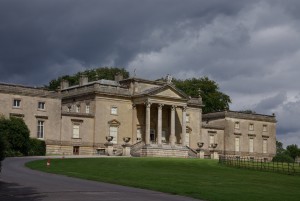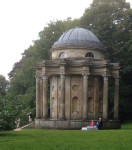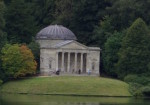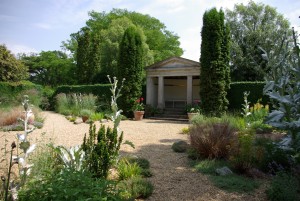What if we suppose Jane Austen made her fortune from the publication of Pride and Prejudice, and she wanted to build a house of the latest architectural style? What would she build? It is a simple and yet rather complicated question when you look at it from a historical perspective.
Jane Austen lived during the Georgian Era (1714-1837). Pride and Prejudice was published during the Regency Period (1811-1820), when the Prince of Wales ruled in the stead of the ailing George III.
Architecture from this period is often referred to as Georgian or Palladian, but not all Georgian architecture is termed Palladian. It can be a bit confusing.
So, what is Palladian exactly? During the early 18th century, The Four Books of Architecture (I Quattro Libri dell’ Archettura-1570) written by 16th century Renaissance architect Andrea Palladio were translated and published in England. The translation of Palladio’s books into English coincided with an increased amount of commerce with the “Far East.” Grand tours and travels brought plenty of artistic influences from the continent, including Italian and Greek art, architecture, Chinese wallpapers and the classic lines of women’s gowns and hairstyles. All of these influences coincided with the birth of the Neoclassical art movement, which referenced back to the Renaissance and Greek and Roman antiquity.
 One of the first Palladian homes built was Stourhead House, completed in 1725. The clarity and symmetry characteristic of Palladian architecture are evident when you view Stourhead from the front. Everything is proportionate. You could fold Stourhead down the middle and the two sides would match perfectly. The parts of the building are in harmony, nothing appears out of place or as if it was stuck on after it was built.
One of the first Palladian homes built was Stourhead House, completed in 1725. The clarity and symmetry characteristic of Palladian architecture are evident when you view Stourhead from the front. Everything is proportionate. You could fold Stourhead down the middle and the two sides would match perfectly. The parts of the building are in harmony, nothing appears out of place or as if it was stuck on after it was built.
Palladian architecture is not overly adorned. It remained within the Roman and Greek conventions as seen in Stourhead’s temple style overhang on the portico, the Corinthian columns, and the statuary on all reference the style. In fact, the statuary on the roof harken back to Etruscan temples, an Italian culture that pre-dated the Roman Empire and was later absorbed by it.
 Stourhead’s gardens reflect the interest in antiquity as well, boasting of three temples: the Temple of Apollo (seen in the 2005 P&P), the Temple of Flora, and a replica of the Roman Pantheon. There is even
Stourhead’s gardens reflect the interest in antiquity as well, boasting of three temples: the Temple of Apollo (seen in the 2005 P&P), the Temple of Flora, and a replica of the Roman Pantheon. There is even  an Italian Grotto, a rocky cave-like structure with a mosaic tile floor and a statue within. Temples were all the rage. They had no true purpose during their heyday, other than decoration, but have found new popularity in fiction as an idyllic location for a failed proposal.
an Italian Grotto, a rocky cave-like structure with a mosaic tile floor and a statue within. Temples were all the rage. They had no true purpose during their heyday, other than decoration, but have found new popularity in fiction as an idyllic location for a failed proposal.
While Stourhead is an early example of Georgian and Palladian architecture, Ickworth in Suffolk (Begun in 1795, but not completed until 1829.), stands as a later incarnation. Ickworth was not meant to be strictly a home, but also an art museum, and as a result, is a massive structure.
 Referred to as “Georgian”, Ickworth expands upon the “Palladian rectangle” by including a rotunda to the center. However, this home has a Greek and Roman element not seen so much in the earlier Georgian homes: a frieze. A frieze is a relief sculptures that wraps around the top of Greek and Roman temples. If you were to stand before the Parthenon, the frieze would be beneath the pediment and above the columns, and often represented battles or mythology. The frieze around the rotunda at Ickworth is said to depict the ancient Olympic games.
Referred to as “Georgian”, Ickworth expands upon the “Palladian rectangle” by including a rotunda to the center. However, this home has a Greek and Roman element not seen so much in the earlier Georgian homes: a frieze. A frieze is a relief sculptures that wraps around the top of Greek and Roman temples. If you were to stand before the Parthenon, the frieze would be beneath the pediment and above the columns, and often represented battles or mythology. The frieze around the rotunda at Ickworth is said to depict the ancient Olympic games.
 Ickworth also boasts of an Italianate garden with a small temple surrounded by a “dry garden.” According to the National Trust, this particular garden pre-dates most Italianate gardens by forty to fifty years, yet does fit the period with the small temple and eastern influence.
Ickworth also boasts of an Italianate garden with a small temple surrounded by a “dry garden.” According to the National Trust, this particular garden pre-dates most Italianate gardens by forty to fifty years, yet does fit the period with the small temple and eastern influence.
So, back to our original question! What would Jane build? If she agreed to adhere to the current style of her time, the house would not be unlike Stourhead or Ickworth, though I cannot imagine Jane ever building something to the scale of Ickworth! The house would be symmetrical and would contain many of the familiar Greek and Roman architectural elements I have mentioned constantly in this post—columns, portico, pilasters and pediments. She might have even splurged on a temple to adorn the gardens!
All we can really do is speculate, of course, but perhaps this gives a bit of an insight into the world she inhabited. Jane mentions current architecture in her works alongside the homes she created in her mind (Pemberley, Norland, and Masfield Park). For example, Landsdown Crescent (Persuasion) is a Georgian building in Bath, which has symmetry and Greek and Roman conventions, but its curves do not truly fit Palladian architecture.
Next time you drive or walk around London or Cambridge, take note of this architecture as it stands out from the Gothic and Tudor buildings which are so prevalent yet are just as impressive. I drove a friend into Cambridge recently for lunch, and we turned a corner to where the very Palladian Fitzwilliam Museum stands (1848-Finished late due to the death of the architect.). I believe her response was, “Wow!”
Sources:
http://www.bbc.co.uk/homes/design/period_georgian.shtml. Accessed 9 Nov. 2014.
http://www.nationaltrust.org.uk/stourhead/ Accessed 9 Nov. 2014.
http://www.nationaltrust.org.uk/ickworth/ Accessed 9 Nov. 2014.
http://www.imagesofengland.org.uk/Details/Default.aspx?id=363171 Accessed 8 Nov. 2014.
http://www.nationaltrust.org.uk/article-1356396834056/ Accessed 8 Nov. 2014
http://www.umich.edu/~ece/student_projects/exoticism/English.htm. Accessed 8 Nov. 2014.
Watkin, David. A History of Western Architecture. 1986 Thames and Hudson.

16 comments
Skip to comment form
Thank you for this post about the architecture of the regency era. I found it very interesting and informative. Neoclassical, yes the female gowns of the era, now that you pointed it out, remind me of ancient Greece.
Author
Very much the waistline of the peplos you see draping the ancient Greek sculptures. If you look at the hair and compare it to the female statues, you’ll find similarities as well. It was interesting that Neoclassical threw back to ancient Greece and Rome and then immediately after came Romanticism, which loved anything exotic. It all kind of led into each other and you still had a few overlapping themes–just different expression. I’m glad you enjoyed it! Thanks, Deborah!
Leslie, how fun! I love any discussion of architecture. It is interesting that you didn’t add the Palladian window that is another way to identify the style. Although if you drove through any upscale development around Atlanta, everything would be Palladian. You could do an architectural tour of Jane Austen sights….I would sign up. Thanks for the great morning read!
Author
Yay! I’m glad you enjoyed it! This post was so difficult to write since Georgian architecture can be broken down into so many sub-categories. I have actually had this piece sitting on my desktop since before I was a member here (I initially wrote it for a guest post last year). I went back and re-read it last week just to realise that I wouldn’t be able to include more without writing a book. 🙂 Palladio influenced so much–especially during that time.
An architectural tour of Jane Austen sites would be fun. I know her house in Chawton was very interesting when I took Jane Hurst’s walking tour. How it changed over the years as well as the extra layer of brick tiles over the one side of the house all made for a fascinating architecture lesson!
Thanks, Maggie!
Thanks for this Leslie. Regency and Georgian eras are my two favourite times in history.
Author
I’ve always found them really interesting. As a culture, we recycle older styles from time to time so it’s interesting to me that it was popular even then. Art and architecture are so influenced by the politics, foreign relations, and cultures of the time period and Regency is such a small time frame that it’s hard to discuss just the architecture there without including the entire Georgian era. I’m just glad y’all have enjoyed it! Thanks, Michelle!
Love these pics. Just give the girl a beautiful house with a garden and a large library and I know she will be happy.
Author
I’m certain Jane would’ve wanted a good library! Thanks, Jen!
It’s a shame Jane never lived to make any money from her wonderful books. If she had I am sure she wold have bought one of those beautiful houses – I know I would love a Palladian house myself! Thanks for this post Leslie 🙂
Author
I agree about Jane! I do think she would be amused at how much of a fan base she has now. Of course, she didn’t really want the recognition. She liked being anonymous. Thanks, Glynis!
Great post Leslie! So many details! I think Jane would love a Georgian manor home with a good prospect! I would love one with a prospect of lake with a bit of woods in the distance!
Author
I’m so glad you enjoyed the post! Personally, I think Jane would be overwhelmed by something too big. Perhaps a nice Longbourn size manor house with the pretty prospect? 🙂 Thanks, Carole!
Both houses seem so intense in comparison with how I see Jane! They’re heavy and foreboding. But that’s a modern me speaking, and not someone who lived with that architecture and accepted it as the norm, the style. Thanks for sharing your knowledge, Leslie!
Author
I don’t see Jane going for something so large. They are just such good examples of what was built at the time from the beginning of the Palladian/Georgian architectural time to the end–where it began and ended. Out of the two homes, I actually prefer Ickworth for the house and Stourhead for the grounds. It’s a bit odd probably, but I will admit that it likely has to do with the art inside Ickworth. Thanks, Suzan!
Interesting but I know I will never have that chance to stroll around and observe. We here in America have few examples of any of these early architectural styles. Oh there are a few but you really have to look for them. I am sure Jane would have kept her house simpler. Yes, the mansions of Rhode Island, Washington DC and those of the south which survived the Civil War might give you some examples. But once you’re west of the Mississippi it becomes much more rare than even those.
Wonderful, informative post. Thank you!